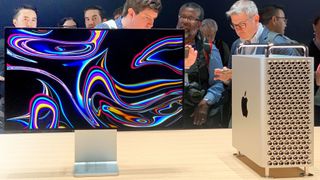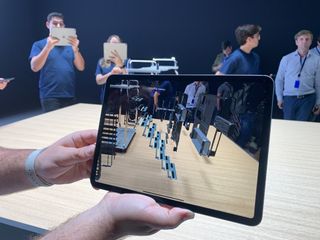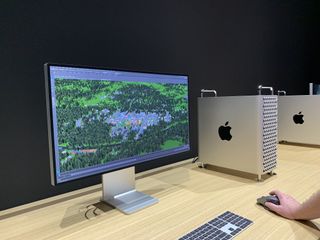Mac Pro (2019) & Pro Display XDR — First Look!

The New Mac Pro and Pro Display XDR are here. I had a chance to chat with some of the people at Apple, including the product team and members of the still pretty new Pro Workflows team, and spend about 90 minutes in the hands-on area watching the new Mac Pro going through its paces.
It's ultra-high-end and has an ultra-high-end price tag to go with it. Which means it's absolutely not for everyone. Many pros will be super happy with the recently updated, more pro-like Mac mini, and even more with the iMac Pro.
But for those for whom time is worth way more than money, and for whom even a well specced out Mac Pro will still cost less than their Red or Alexa camera, never mind the several they have in production, or all the audio gear and instruments they use, or lab equipment, or whatever, this is exactly what they want — A Pro Mac that's literally almost without limits.
Rather watch than read? Hit play on the video above!
New Mac Pro: The Design
The best news ever is — the New Mac Pro… is a lot like the old Mac Pro. No, not the trash can. The cheese grater. The fantastically engineered, almost endlessly accessible and expandable tower of Yore. And thanks to its 3D grill system, it even looks more like a cheese grater than ever before. Yeah, turns out, that was entirely possible.
I have an old Nahelem Mac Pro. An old cheese grater, and with new cards and some love, it's still as good as anything out there. That's the value of this design philosophy. You don't just get a Mac Pro for today, you get a Mac Pro that can be updated for years to come, and maybe hacked on for a decade or more.
Time will tell, of course. But it just feels like such a huge win. Modular but not in an unnecessarily weird, overly complicated, or wacky way. It has modules, like the Mac Pro Expansion Module, or MPX, and the Afterburner Pro Res accelerator.
Master your iPhone in minutes
iMore offers spot-on advice and guidance from our team of experts, with decades of Apple device experience to lean on. Learn more with iMore!
It's even easier to open than the old cheese grater. Just turn the latch and you can pull the aluminum housing up and gain complete, 360 degree access to the Mac Pro and its dual sided board.
You can put wheels on it if you really want to, and if you'd rather rack mount it than stand it up, Apple will have a model expressly designed for that, but otherwise identical in every way, available for you at launch.
New Mac Pro: The Specs.
Now, I'm not going to focus on specs. Don't get me wrong. They're ludicrous. From the up to 28 Xeon cores — the brand new Cascade Lake optimized for workstations that Intel announced at the same time — and up to 64 PCI Express lanes, 300 watts of power, up to 1.5TB of ECC memory, four double-wide PCI Express slots, three single-wide slots, and one half-length slot preconfigured with the Apple I/O card, up to 4 TB of SSD protected b the Apple T2 security chip, Thunderbolt. 3 ports on the top and bottom, USB A ports on the front, two 10 GB Ethernet, and that's just the beginning.

You can read all of them off Apple.com or, likely, see them in every other video hitting YouTube right now.
It's basically a thermally unconstrained monster of a machine. It's power, packed. It's very close to no compromises when it comes to everything… provided you're willing to pay for it.
Except for the one thing you still can't pay for:
There's still no Nvidia graphics options though. Apple won't talk about Nvidia the way they won't talk about Intel's tardiness with chips or continued lack of process shrinks.
But, it's my understanding Nvidia still won't let Apple write to the metal, which means directly to the hardware, and instead want them to jump through Nvidia's hoops. And, the problem with that is that it destroys the integration and ease of transport Apple provides developers thanks to things like Metal.
So, Apple is just working around them — and through them — by doing things like MPX to make AMD a faster option, and working with developers to get all the leading 3D packages ported over to the Mac.
New Mac Pro: The Workflows
But, what I really want to focus on is the workflows. Apple has a fairly new Pro Workflows team that reports into John Ternus and the same team making all the new Pro machines. In typical Apple fashion, they went and recruited the real engineers and creators who worked in the big Hollywood studios, special effects houses, music production facilities, and on and on, and just have them in-house now, hammering on the Pro hardware and software so features can be specced and problems caught and fixed long before any specific products are announced.

It's something so smart I can't believe Apple didn't start doing it a decade or more ago.
And what they showed off here included things like 3 streams of 8K pro res video playing back in real-time, without so much stammer, on the fully decked out Mac Pro with MPX and Afterburner in Final Cut Pro.
Virtual instruments deeper than any symphony in the world, probably several, playing back without a hitch in Logic Pro X.
And a Pixar set from Toy Story 4. An interior you could pull back on to see the whole building, and pull back again to see the whole park, and again to see the whole area. Just polygons being thrown out so fast, so far. It was beyond impressive.
5. New Mac Pro: The Pro Display XDR
A few years ago, Apple canceled the Thunderbolt Display. And… that remains true today. Apple hasn't come anywhere near replacing that sub $1000 consumer panel for everyone. Instead, what Apple is doing is directly taking on the $20K to $30K reference monitors typically found in production studios.

I got to see a bake-off between the Pro Display, a consumer HDR display, a higher-end display that cost a couple thousand bucks, and the LCD and OLED Sony reference monitors that cost up there in the $20K to $30K price range and…
The Pro Display just absolutely slaughtered them. The HDR display was trying so hard to be bright it distorted the colors. The $2K display was just dark and muddy. And the Sony displays shifted off-axis and couldn't maintain consistent brightness for more than a few seconds or minutes in most white-heavy cases. And those tap out at 4K. The Apple Pro Display is 6K — 6016 x 3384 and can hit peak brightness of 1600 nits and maintain 1000 nits effectively all day, every day. And it costs 1/3 to 1/5 the price.

So, yes, it's super expensive and announcing the $1K pro Stand during the keynote just sucked the air out of what had been up until then a really well-received product.
But it's not designed for casual users. It's designed so that, instead of having one $45K reference monitor in your studio's color grading station, and everyone else trying to guess on cheaper LCDs, a company can get 3-6 Pro Displays instead and have everyone in the workflow or pipeline all working color accurate to begin with.
It totally sucks that most of us won't be able to afford it. I really hope Apple takes everything they learned making this display and figures out how to offer a next-generation 27-inch iMac or Thunderbolt-style display that may not have all the ultra-high end bells and whistles, but that gives all of us who still want that Apple display and Apple display we can afford. For around a $1000 bucks, regular old stand included.
But after years of us demanding real high-end Pro hardware with no compromises, that's what we're getting.
And to everyone who's spent the last year or so worried that Apple was forgetting about the Mac and about Pros, this was the culmination of the last year, from MacBook Air, to mini, to MacBook Pro, to iMac Pro, to, now Mac Pro, of Apple saying don't worry. We gotchu.
We'll show you what a real no limits Mac and Pro Display can really do.
The New Mac Pro starts at $5,999 and just goes up — way up — from there. The Pro Display XDR starts at $4999 for regular or $5999 for a matte version that eschews a film for nano-etching. And you can get it either with a VESA mount for $199 or that crazy Pro Stand I mentioned for an extra $999.
And it'll be available this fall.

Rene Ritchie is one of the most respected Apple analysts in the business, reaching a combined audience of over 40 million readers a month. His YouTube channel, Vector, has over 90 thousand subscribers and 14 million views and his podcasts, including Debug, have been downloaded over 20 million times. He also regularly co-hosts MacBreak Weekly for the TWiT network and co-hosted CES Live! and Talk Mobile. Based in Montreal, Rene is a former director of product marketing, web developer, and graphic designer. He's authored several books and appeared on numerous television and radio segments to discuss Apple and the technology industry. When not working, he likes to cook, grapple, and spend time with his friends and family.
Most Popular


